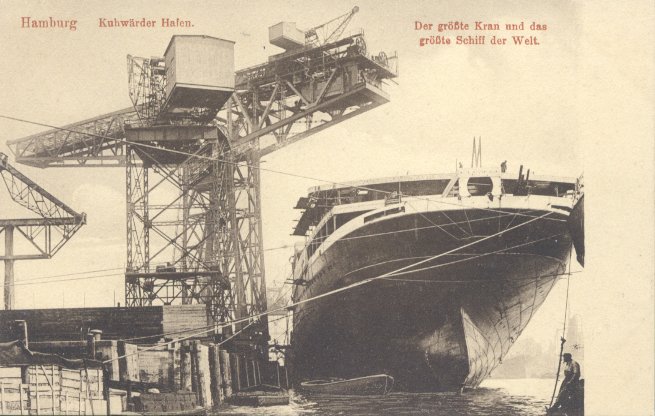Vaterland was the second of Albert Ballin's trio of great ships intended
to be Hamburg Amerika Line's answer to the Cunard and White Star
four-stackers.
Built by Blohm & Voss of Hamburg, she was launched in 1913 and made her
maiden voyage from Cuxhaven to New York on 14 May 1914. She was the
largest ship in the world at the time (54,282 tons), a title she would
retain until her sister
Bismarck/Majestic
came on the scene. She and Bismarck also shared a novel design feature:
the uptakes which led from her furnaces to her funnels were split and
ran along the outside of the ship, rather than straight up the middle.
This allowed for much bigger public rooms, undivided by funnel uptakes,
than had been possible on earlier ships.
Vaterland was in Hoboken, New Jersey, in the middle of her fourth
transatlantic roundtrip when World War I began. She remained there
almost three years, interned. When the United States entered the war in
1917, Vaterland was seized and converted into a troop carrier. She was
renamed Leviathan, reportedly by Woodrow Wilson himself. In March
1919 she carried 14,416 U.S. troops home, the largest number of people
ever to sail on one ship.
When her trooping duties were over, Leviathan was laid up, again at
Hoboken, and handed over to the United States Shipping Board. The Board
then arranged to have the International Mercantile Marine Corp. operate
her and IMM's chief designer, William Francis Gibbs, began Leviathan's
re-conversion to a passenger ship. The plan to allocate her to IMM was
abandoned in 1922 after William Randolph Hearst successfully challenged
that plan in court, but Gibbs remained involved. He left IMM and
supervised the restoration; he also operated the first six crossings
Leviathan made for the Shipping Board's newly-created United States
Lines in 1923. When the reconstruction was completed, Leviathan was
measured at a widely-doubted 59,956 tons, which (if credible) again made
her the largest ship in the world at that time and the largest American
ship ever.
She began New York-Southampton service on 4 July 1923. Although
passenger loads were high until the late 1920's, Leviathan was never
truly profitable due to high operating costs, the competitive
disadvantage of being an alcohol-free American ship during Prohibition
and the lack of a suitable running mate. In 1929, United States Lines
passed into private ownership, which also failed financially. Finally,
in 1931, IMM acquired United States Lines, and Leviathan was remeasured
at 48,932 tons, thereby conceding Majestic's superiority (but also
saving on harbor fees based on tonnage).
Leviathan remained in service until the spring of 1933, and was then
largely laid up. She made only five more transatlantic trips in 1934.
She was withdrawn from service after arriving at New York 14 September
1934, and was laid up, once more at Hoboken, for the next three years.
She was sold for breaking up at Rosyth in December 1937 and arrived there
under her own power in February 1938.



